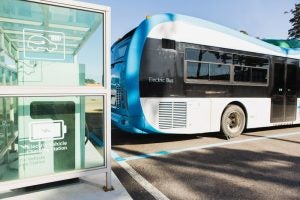 By Christie Hicks and Andrew Barbeau
By Christie Hicks and Andrew Barbeau
This post is the third in our CEJA series.
As Illinoisans consider ways to drive down pollution and the costs of energy, one place to look is what they drive.
The transportation sector has now overtaken the power sector as the leading source of carbon pollution in Illinois, responsible for nearly one-third of all carbon emissions. Any state-level climate action must address transportation emissions.
That is why electrification of the transportation sector is one of the four key pillars of the newly-introduced Clean Energy Jobs Act (CEJA). By incentivizing electric vehicles (EVs), mass transit and other transportation alternatives, we can remove the equivalent of a million gas and diesel-powered vehicles from the road. Doing so will have immediate air quality benefits, especially in low-income communities and communities of color that bear the biggest burden of this pollution.
EV access for all
Across the state, we’ve heard a desire to expand EV access to all customers. We can do this by ensuring new EV infrastructure and programs are equitably distributed throughout the state, so that all Illinoisans have the opportunity to benefit from them.
Equity, innovation can be part of Illinois’ efforts to electrify transportation Share on XAs we begin electrifying our transportation sector, we must do it in a beneficial way. This means that as we plug more cars into the grid, we are drawing from the cleanest energy sources and saving all customers money. Indeed, we believe that if we add a significant amount of electric vehicles to the grid and have owners participate in beneficial electrification programs that optimize when they charge – by incentivizing charging at off-peak hours, when we have extra renewable capacity – we can generate big savings.
In addition, the benefits of EVs should extend beyond residential car owners. Programs in CEJA would reduce pollution from fleets of diesel trucks and buses, and provide unique opportunities for access to shared EVs.
For example, CEJA would create “EV Access for All” programs to target communities across the state — specifically, low-income communities, environmental justice communities and communities with low car ownership. For example, a new “last mile of commute program” would connect the first or last mile of a commute to help encourage the use of alternative transportation. Eligible programs may include electric shuttles, electric and non-electric bicycle and scooter sharing, electric vehicle sharing and other carbon-free alternatives.
This program would address the needs of people who live and work in so-called transit deserts. Currently, people without easy access to transit from their home or work may commute an entire trip in their own vehicles. Providing a carbon-free “last mile” option could enable a larger number of citizens to access public transportation and significantly decrease the emissions of their commute.
The bill would also create a “low-income EV car sharing” program in communities where people face barriers to car ownership. CEJA would expand on current pilot programs and enable entire communities and ride-share drivers to access car sharing in a central location.
The authors of CEJA have developed a plan that leverages the electrification of Illinois’ transportation sector to lower energy costs for all consumers, promote equity and directly benefit communities already over-burdened by pollution. Together, with the clear pollution-reduction benefit that comes with clean electrification, CEJA’s transportation initiatives are good for Illinois’ commuters, customers and air quality.









